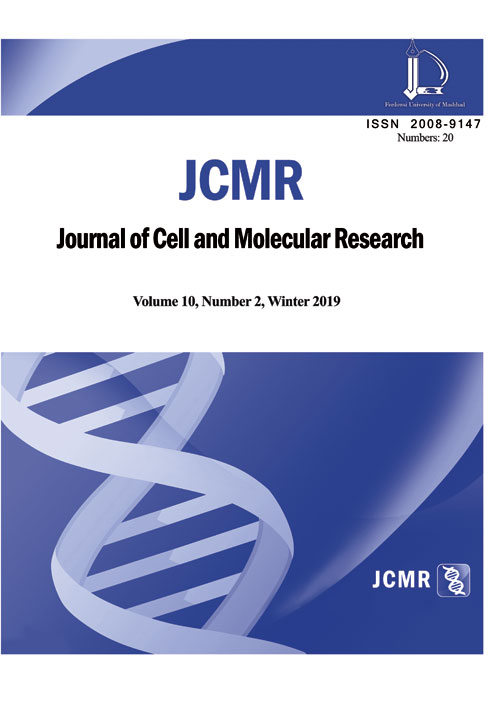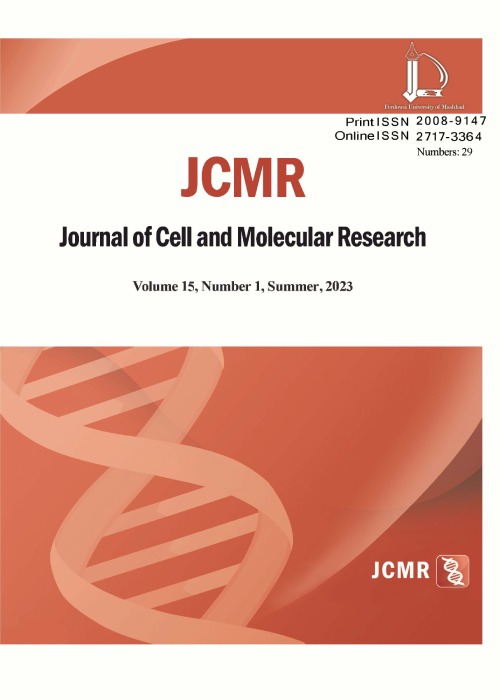فهرست مطالب

Journal of Cell and Molecular Research
Volume:10 Issue: 2, Winter and Spring 2019
- تاریخ انتشار: 1398/02/01
- تعداد عناوین: 6
-
-
Pages 52-58There are several studies suggesting the role of aneuploidy in tumor formation. Aneuploid cells are different from normal ones in term of gene expression and proteome. Cells with different amount and kind of proteins might act differently to external stimuli, including ionizing irradiation. Currently, radiotherapy is one of the main methods in fight against cancer, therefore, it is important to understand the response of the aneuploidy-tumor cells to irradiation. To investigate the chromosomal effect of gamma irradiation on aneuploid cells, L929 cells were treated with 1.5 ng.ml-1 of vinblastine to induce aneuploidy. Vinblastine-treated cells were left to recover for 72 h and irradiated with 1 Gy of gamma radiation. Induced chromosomal damages were investigated using micronucleus (Mn) assay. Data showed that vinblastine and gamma irradiation both were able to significantly increase micronucleated-binucleated cells (MnBi) frequency. However, 1 Gy gamma irradiation of the cells after 72 h of vinblastine treatment led to the lower frequency of MnBi compared to irradiated cells. Results of this study suggest that vinblastine treatment of cells before irradiation not only did not sensitize the cells to radiation-induced chromosomal abnormalities, but also had radio-protective effect for these cells. This result could be useful in planning cancer therapy regimes.Keywords: Gamma, Vinblastine, L929 cells, Micronucleus assay, Binucleated cells
-
Pages 59-66There are different subtypes of brain tumors, classified according to the origin of the abnormally proliferated glial cells. Glioblastoma multiforma (GBM) is the grade 4 of brain tumors, gliomas, with the least life expectancy. microRNAs (miRNAs) are small, single stranded, non-coding RNAs with 20-25 nt length with post-transcriptional gene regulatory activities. An altered expression of miRNAs is linked to developmental disorders and some diseases, most importantly cancers. miR-21 is a well-known microRNA, overexpressed in almost all cancer types, including brain tumors. It targets several genes with vital roles in cellular pathways involve in proliferation, invasion and metastatic behaviors. Exosomes are 30-100 nm extracellular vesicles which are packed with various molecules, including miRNAs. Here, we suppressed miR-21 expression level in HEK-293T cells by transfecting them with the miRZip-21 vector. However, when U87-MG cells were cultured in the presence of exosomes isolated from conditioned medium of engineered HEK-293T cells derived exosomes, we did not observe any suppressing effect on host cells’ miR-21 expression level. Moreover, by analyzing the effects of miRZip-21-enriched cell’s conditioned media on three other brain cell lines including 1321N1, A-172 and DAOY, cell type-specific effects of exocrine miRZip-21 were revealed. These data suggested that cell lines from different brain tumor subtypes could exert different responses to microRNAbased therapies, based on their cellular origin and clinical behaviors.Keywords: miR-21, Brain tumors, Glioblastoma multiforma, Exosomes
-
Pages 67-75Aryl hydrocarbon receptor (AHR) is a ligand-activated transcription factor and its induction may result in suppressing of cell proliferation in colorectal cancer (CRC). Cucurbitacin D (CucD), E (CucE) and I (CucI) are plant derived metabolites that inhibit cancer cells. This study aimed to evaluate the possible potency of the cucurbitacins for activation of AHR expression in CRC cell lines SW-480 and HT-29. The MTT assay was used to find the IC50 value of the metabolites in the cell lines. Afterwards, the cells were incubated with the IC50 concentrations of the cucurbitacins and AHR-mRNA expression assessed using RT-PCR. The IC50 values of CucD, CucE, and CucI were 4.5, 6.8, and 3.8 μM in HT-29 cell line and 35, 19, 17.5 μM in SW-480 cells, respectively. The SW-480 cells were more resistant against cucurbitacins in comparison with HT-29 cells and all three cucurbitacins led to more AHRmRNA expression in HT-29 cells. CucE had the lowest effect on AHR-mRNA expression in the cell lines and CucI was a common metabolite for both HT-29 and SW-480 cells, which showed the lowest IC50 value (the highest toxicity) and the highest effect on AHR-mRNA expression. CucI may have a potential AHR-induction role and it could be applicable as an AHR-expression inducer in CRC studies.Keywords: Aryl hydrocarbon receptor, Colon cancer, Cucurbitacin, HT-29, SW-480
-
Pages 76-89Zucchini yellow mosaic virus (ZYMV) is one of the most economically important viruses infecting cucurbits worldwide. Population genetic analysis of ZYMV was conducted based on the virus cylindrical inclusion (CI) gene sequences of 10 isolates identified in this study and 94 other isolates from different countries in six continents: Asia, Europe, Oceania, Africa, North and South America. The overall mean value of nucleotide sequence diversity among all isolates was 0.074±0.006. Phylogenetic analysis showed that ZYMV isolates fell into three main phylogroups with significant FST values (>0.55) and almost tended to cluster according to their geographical position. Group I was predominant and contained isolates originated from different parts of the world. Iranian isolates clustered into group I, sharing 87.7-99.7% and 92.5–100% nucleotide and amino acid identity, with other isolates of this group. Group II was a new group that included only Singapore isolates. Group III including East Timor, Reunion Island and Australia- Kununurra isolates which were genetically differentiated from other populations. ZYMV populations from different geographic origins were composed of multiple lineages. With exception of the Oceanian population which was strongly differentiated from the American population, most other geographical populations showed low to moderate genetic differentiation. There was moderate to high level of gene flow despite large separating geographic distances. Analysis of the synonymous-to-nonsynonymous ratio showed strong purifying selection in the CI gene. The analyses indicated that in addition to selection, random processes such as genetic drift and founder effects are important determinants for the genetic structure of populations of ZYMV.Keywords: Cylindrical inclusion, Evolutionary forces, Genetic variability, Zucchini yellow mosaic virus
-
Pages 90-96Aspergillus fumigatus is one of the pathogenic filamentous fungi that could cause opportunistic infection, allergy and poisoning. Since, genetic sequencing of some of these fungi has been completed, identifying the protein profile of these fungus cells is necessary. One of these genes is the Annexin family. Annexin C4 is a new member of fungal annexins. This study investigates the effect of ANXC4 mutant gene in proteome profile of Aspergillus Fumigatus. Moreover, in order to enhance the power of protein complex separation, we used an optimized prefractionation method. Using reverse phase-high performance liquid chromatography eight fractions were separated. Then to confirm the protein concentration, each fraction was tested by SDS-PAGE. Protein profile of these fractions was analyzed using 2-DE, and Image Master software. Among the proteins identified statistically, two emerging proteins were observed. The results show that the expression of ANXC4 could affect the expression of some proteins in A.Fumigatus. To accurately identify these proteins, further experiments are needed including Mass spectrometry analysis.Keywords: Aspergillus Fumigatus, RP-HPLC, 2-DE, Prefractionation, Proteome profile
-
Pages 97-101Erythritol as a non-caloric and non-cariogenic sweetener is safe for diabetics. Both microbial fermentation and chemical methods can be used to produce erythritol, but chemical methods failed to be industrialized due to their low efficiency. Moniliella tomentosa, Aureobasidium sp. and Yarrowia lipolytica are industrial producers of erythritol. Erythrose reductase (ER) is a key enzyme in the biosynthesis of erythritol and catalyzes the final step in this pathway. Enzyme extract was obtained from Y. lipolytica by grinding cells with 0.5mm glass beads and ER activity was performed using 10 μl enzyme extract, 7.5 mM NADPH and 12 mM D-erythrose in potassium phosphate buffer (pH 7.5). Reaction was monitored with decreasing of NADPH absorbance in OD340 at 37 ˚C for 8 min by a microplate analyzer. In order to determine the activation energy (Ea), activity of enzyme was measured in 4-45 ˚C and results were analyzed with Kinetic software according to Arrhenius equation. The best enzyme activity of ER was 6.268 mU. One unit of ER activity was defined as the amount of enzyme that catalyzes the oxidation of 1μmol of NADPH per minute. Specific activity of enzyme was equal to 3.24U/mg and finally the Ea was determined to be 29.6208 KJ.ER specific activity in this study was lower than the only similar study that used Y. lipolytica. Purification, overexpression and optimizing the reaction can help to increase enzyme performance.Keywords: Erythrose reductase, Yarrowia lipolytica, Enzyme kinetics


